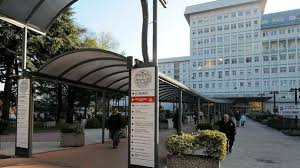- Authors:
-
Carta, Angela; Pavanello, Sofia; Mastrangelo, Giuseppe; Fedeli, Ugo; Arici, Cecilia; Porru, Stefano
- Title:
-
Impact of Occupational Exposures and Genetic Polymorphisms on Recurrence and Progression of Non-Muscle-Invasive Bladder Cancer
- Year:
-
2018
- Type of item:
-
Articolo in Rivista
- Tipologia ANVUR:
- Articolo su rivista
- Language:
-
Inglese
- Format:
-
Elettronico
- Referee:
-
Sì
- Name of journal:
- INTERNATIONAL JOURNAL OF ENVIRONMENTAL RESEARCH AND PUBLIC HEALTH
- ISSN of journal:
- 1660-4601
- N° Volume:
-
15
- Number or Folder:
-
8
- Page numbers:
-
1563-1563
- Keyword:
-
bladder cancer; non-muscle-invasive bladder cancer; recurrence; progression; occupational exposures; genetic polymorphisms; MnSOD; COMT
- Short description of contents:
- Introduction: Additional or better markers are needed to guide the clinical monitoring of patients with non-muscle-invasive bladder cancer (NMIBC). Aim: To investigate the influence of occupational exposures and genetic polymorphisms on recurrence and progression of NMIBC. Methods: The study includes 160 NMIBC patients. We collected on questionnaire information on demographic variables, lifetime smoking history, lifetime history of occupational exposure to aromatic amines and polycyclic aromatic hydrocarbons. Genetic polymorphism (glutathione S-transferase M1; T1; P1 (GSTM1; GSTT1; GSTP1); N-acetyltransferase 1; 2 (NAT1; NAT2); cytochrome P450 1B1 (CYP1B1); sulfotransferase 1A1 (SULT1A1); myeloperoxidase (MPO); catechol-O-methyltransferase (COMT); manganese superoxide dismutase (MnSOD); NAD(P)H:quinone oxidoreductase (NQO1); X-ray repair cross-complementing group 1; 3 (XRCC1; XRCC3) and xeroderma pigmentosum complementation group (XPD)) was assessed in peripheral blood lymphocytes. DNA adducts were evaluated by 32P-postlabeling. Predictors of recurrence (histological confirmation of a newly found bladder tumor) and progression (transition of tumor from low-grade to high-grade and/or increase in TNM stage) were identified by multivariate Cox proportional hazard regression with stepwise backward selection of independent variables. Hazard ratios (HR) with 95% confidence interval (95%CI) and two-tail probability of error (p-value) were estimated. Results: The risk of BC progression decreased with the homozygous genotype "ValVal" of both COMT and MnSOD (HR = 0.195; 95%CI = 0.060 to 0.623; p = 0.006). The results on BC recurrence were of borderline significance. No occupational exposure influenced recurrence or progression. Conclusion: Our results are supported by experimental evidence of a plausible mechanism between cause (ValVal genotype of both MnSOD and COMT) and effect (decreased progression of tumor in NMIBC patients). The genetic polymorphisms associated with better prognosis may be used in clinic to guide selection of treatment for patients initially diagnosed with NMIBC. However, external validation studies are required.
- Product ID:
-
103819
- Handle IRIS:
-
11562/983640
- Last Modified:
-
November 28, 2022
- Bibliographic citation:
-
Carta, Angela; Pavanello, Sofia; Mastrangelo, Giuseppe; Fedeli, Ugo; Arici, Cecilia; Porru, Stefano,
Impact of Occupational Exposures and Genetic Polymorphisms on Recurrence and Progression of Non-Muscle-Invasive Bladder Cancer
«INTERNATIONAL JOURNAL OF ENVIRONMENTAL RESEARCH AND PUBLIC HEALTH»
, vol.
15
, n.
8
,
2018
,
pp. 1563-1563
Consulta la scheda completa presente nel
repository istituzionale della Ricerca di Ateneo 








